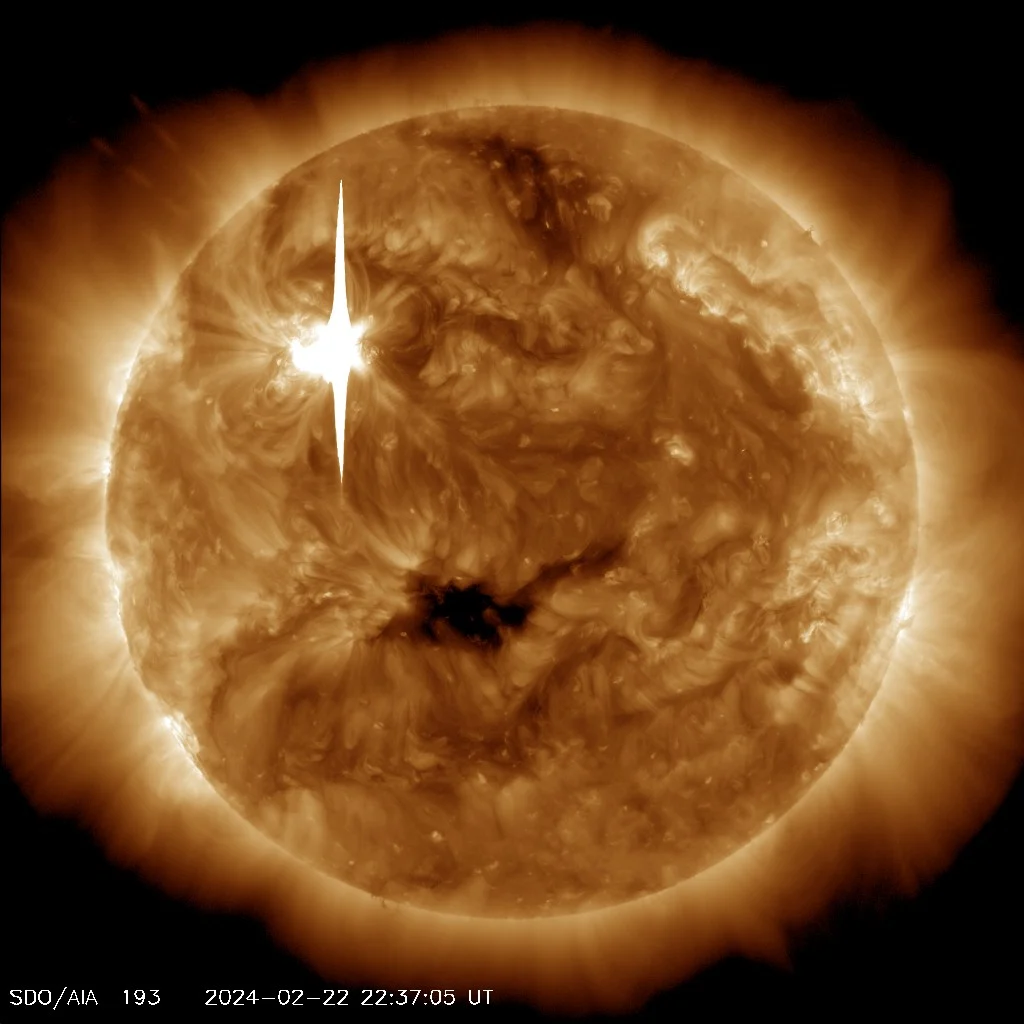The X6. 3 flare did not cause a coronal mass ejection, but it may cause GPS and radio communication failures.
The Space Agency reported the flare peaking at 17:34 Eastern Standard Time (EST) on February 22, 2024 (22:34 Coordinated Universal Time (UTC)), which it classified as an X6.3 event.
Solar flares are classified into five categories: A, B, C, M, and X. A Class C flash is ten times more powerful than a Class B flash, and a Class M flash is ten times more powerful than a Class C flash. Flares are also evaluated by a numerical value to indicate the magnitude of the event.
Thus, Class X outbreaks are the most dangerous. And this flash was very big: the list of historical solar flares on Space Weather Live suggests that the new flare was the 27th most powerful on record and the most dangerous since 2017. The most powerful event on the list was classified as X40.
The X6.3 outbreak followed the X1.8 outbreak on Wednesday and the X1.7-rated event earlier on Thursday. Here's a NASA snapshot of the X6.3 flash.

The US National Oceanic and Atmospheric Administration warned that the X6.3 event could cause "temporary deterioration or complete loss of signal" for high-frequency radio operators – at least on the solar side of the planet at the time of the outbreak - and added that the event "does not pose a significant threat to the public."
However, the agency previously advised that all flashes can affect radars and GPS.
Solar flares can pose a significant threat to astronauts because of the dangerous radiation they release. This raises concerns among the seven crew members of the International Space Station (ISS) and the three astronauts stationed at China's Tiangong orbital station, especially if the current solar flare activity increases. The ISS crew doesn't have any spacewalk tasks scheduled for this coming weekend.
Although the outbreaks are significant, they did not cause the mobile phone problems experienced in the United States on Thursday.
A Class X solar flare can cause disruptions to radio communications and navigation systems, but a much bigger threat is a coronal mass ejection, which can throw billions of tons of solar plasma into space. Such an outburst can reach the Earth, causing large-scale geomagnetic storms that pose a threat to power grids, satellites, and communications infrastructure. However, if a Class X flare is not accompanied by a significant coronal mass ejection, as appears to be the case today, its direct impact on Earth's technological systems is significantly less.
These flares occurred during the 25th solar cycle, which began in 2019 and will last until 2030, with an expected peak of activity in 2025. The X6.3 class flare has become the most powerful in the current cycle, but there is a high probability that it will give way to larger events in the future.
The Space Agency reported the flare peaking at 17:34 Eastern Standard Time (EST) on February 22, 2024 (22:34 Coordinated Universal Time (UTC)), which it classified as an X6.3 event.
Solar flares are classified into five categories: A, B, C, M, and X. A Class C flash is ten times more powerful than a Class B flash, and a Class M flash is ten times more powerful than a Class C flash. Flares are also evaluated by a numerical value to indicate the magnitude of the event.
Thus, Class X outbreaks are the most dangerous. And this flash was very big: the list of historical solar flares on Space Weather Live suggests that the new flare was the 27th most powerful on record and the most dangerous since 2017. The most powerful event on the list was classified as X40.
The X6.3 outbreak followed the X1.8 outbreak on Wednesday and the X1.7-rated event earlier on Thursday. Here's a NASA snapshot of the X6.3 flash.

The US National Oceanic and Atmospheric Administration warned that the X6.3 event could cause "temporary deterioration or complete loss of signal" for high-frequency radio operators – at least on the solar side of the planet at the time of the outbreak - and added that the event "does not pose a significant threat to the public."
However, the agency previously advised that all flashes can affect radars and GPS.
Solar flares can pose a significant threat to astronauts because of the dangerous radiation they release. This raises concerns among the seven crew members of the International Space Station (ISS) and the three astronauts stationed at China's Tiangong orbital station, especially if the current solar flare activity increases. The ISS crew doesn't have any spacewalk tasks scheduled for this coming weekend.
Although the outbreaks are significant, they did not cause the mobile phone problems experienced in the United States on Thursday.
A Class X solar flare can cause disruptions to radio communications and navigation systems, but a much bigger threat is a coronal mass ejection, which can throw billions of tons of solar plasma into space. Such an outburst can reach the Earth, causing large-scale geomagnetic storms that pose a threat to power grids, satellites, and communications infrastructure. However, if a Class X flare is not accompanied by a significant coronal mass ejection, as appears to be the case today, its direct impact on Earth's technological systems is significantly less.
These flares occurred during the 25th solar cycle, which began in 2019 and will last until 2030, with an expected peak of activity in 2025. The X6.3 class flare has become the most powerful in the current cycle, but there is a high probability that it will give way to larger events in the future.
